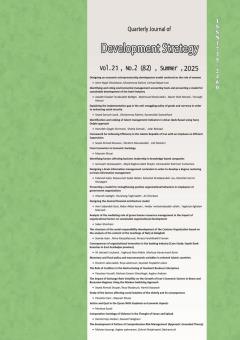Monetary and fiscal policy and macroeconomic variables in selected Islamic countries
Subject Areas : EconomicEbrahim safarzadeh 1 , Roya aleemran 2 , seyyed ali paytakhti oskooe 3
1 - PhD student, Department of Economics, Tabriz Branch, Islamic Azad University, Tabriz, Iran.
2 - Department of Economics, Tabriz Branch, Islamic Azad University, Tabriz, Iran
3 - Associate Prof., Department of Economics, Tabriz Branch, Islamic Azad University, Tabriz, Iran
Keywords: Monetary and fiscal policy, macroeconomic variables, Islamic countries.,
Abstract :
To implement a successful monetary and fiscal policy, it is necessary for economic authorities to have a correct assessment of the time and extent of the impact of this policy on economic variables. For this purpose, adequate understanding and recognition of the tools and mechanisms through which the monetary and fiscal policy affects the economic sectors is necessary. Therefore, developing a monetary and fiscal strategy appropriate to the economic conditions in countries such as Iran and Islamic countries such as Saudi Arabia, Kuwait, etc., which are concerned with Islamic economic policy and the elimination of interest rates and the implementation of economic justice, is of great importance. In order to collect the required information, this research was done from various tools such as internal websites and visiting libraries. Also, EXCEL software and EVIEWS13 statistical software were used to test the hypotheses and finally analyze the data. The research results have been examined in the form of eight hypotheses and the results show that the effect of fiscal policy in selected Islamic countries on the variables of GDP, price index and interest rate is positive and significant, and the effects of this policy on the exchange rate are negative and significant.
-داودی پرویز و سزاوار محمد رضا ( 1401)؛ بررسی افزایش نرخ ارز و تأثیر آن بر برخی متغیرهای کلان اقتصادی ایران در شرایط تحریم ،پژوهشهای اقتصادی ( رشد و توسعه پایدار ) 32(4): 99-117
-زورکی شهریار؛ نصرنژادد سحر و توسلی نیا علی ( 1401) ، تحلیل اثر متغیرهای کلان اقتصادی بر اقتصاد زیرزمینی در ایران با تاکید بر ابزارهای سیاست مالی دولت، فصلنامه تحقیقات اقتصادی، 57(1):123-85.
-غنی نژاد موسی (1396) ، اقتصاد و دولت در ایران ، تهران : دنیای اقتصاد.
-مهدیلو، علی، اصغرپور ، فلاحی، فیروز (۱۳۹۸). مکانیزم انتقال غیرخطی سیاست پولی از کانال قیمت مسکن در ایران: رویکرد MSVAR، فصلنامه پژوهشها و سیاستهای اقتصادی، 27(90): ۴۹۹-۴۵۵.
-وفامند، ع. ح.، و فلاحی، چ. (1397). بررسی اثرات شوکهای پولی بر تولید: رویکرد Markov-switching DSGE. فصلنامه پژوهشها و سیاستهای اقتصادی, ۲۶(۸۸), ۲۰۹-۲۴۴.
-اندرو، و. (1391). نظریههای دولت ،ح. بشیریه، مترجم. تهران: نشر نی
-Alvarez, J., and Arellano, M. (2003). The time series and crosssection asymptotics of dynamic panel data estimators. Econometrica 71, 1121–1159.
-Aragon, E. K. and Portugal, M. S.(2009), "Asymmetric Effects of Monetary Policy in brazil", Estudos Economicos, vol.39 no.2, pp. 277-300.
-Nguyen Canh and Dinh Thanh ( 2011) , Asymmetric impacts of monetary policy and business cycles on bank risk-taking: Evidence from Emerging Asian markets, The Journal of Economic Asymmetries, Volume 24, November 2021, e00221.
-Weise, C.(1999), "The Asymmetric Effects of Monetary Policy: A Nonlinear VectorAutoregression Approach", Journal of Money, Credit and Banking, Vol 31, pp. 85–108.
-Yunxian Wang, Xin Wang, Zheng Zhang, Zhanmin Cui, and Yuan Zhang ( 2023 ) Role of fiscal and monetary policies for economic recovery in China, Economic Analysis and Policy.


